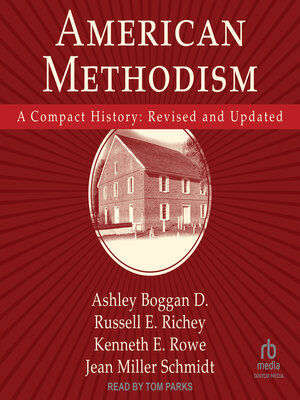American Methodism
audiobook (Unabridged) ∣ A Compact History: Revised and Updated
By Kenneth E. Rowe

Sign up to save your library
With an OverDrive account, you can save your favorite libraries for at-a-glance information about availability. Find out more about OverDrive accounts.
Find this title in Libby, the library reading app by OverDrive.



Search for a digital library with this title
Title found at these libraries:
| Library Name | Distance |
|---|---|
| Loading... |
The essential guide to American Methodism revised and updated through 2020.
American Methodism Revised and Updated begins with the explosion of evangelical Pietism and revolutionary Methodism, the First Great Awakening, as an independent nation was formed.
It then highlights key nineteenth century themes and Methodist contributions, such as spreading scriptural holiness through missions and literature, planting tens of thousands of Sunday schools and churches by Circuit Riders, the pivotal Methodist schism between abolitionists and enslavers, the innovative building of schools and hospitals into the next century, and the revivalism of the Second Great Awakening.
Finally it explores the movements of twentieth century Methodism, including the expansion of home and foreign missions, the Methodist drive for Prohibition, the decision for nationwide reunification on the cusp of World War II, reunification with the United Brethren during the Vietnam War, the Methodist ordination of women during the 1950s, Black Methodist leadership in the 1960s Civil Rights movement, and the liturgical renewal or reformation of worship (ancient and future).
American Methodism Revised and Updated begins with the explosion of evangelical Pietism and revolutionary Methodism, the First Great Awakening, as an independent nation was formed.
It then highlights key nineteenth century themes and Methodist contributions, such as spreading scriptural holiness through missions and literature, planting tens of thousands of Sunday schools and churches by Circuit Riders, the pivotal Methodist schism between abolitionists and enslavers, the innovative building of schools and hospitals into the next century, and the revivalism of the Second Great Awakening.
Finally it explores the movements of twentieth century Methodism, including the expansion of home and foreign missions, the Methodist drive for Prohibition, the decision for nationwide reunification on the cusp of World War II, reunification with the United Brethren during the Vietnam War, the Methodist ordination of women during the 1950s, Black Methodist leadership in the 1960s Civil Rights movement, and the liturgical renewal or reformation of worship (ancient and future).







